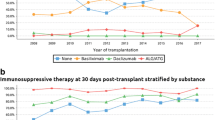Abstract
Purpose
The use of basiliximab induction increased significantly in recent years based on its superior efficacy and excellent safety profile demonstrated in studies with cyclosporine-based immunosuppression. However, its clinical utility in patients receiving tacrolimus-based immunosuppressive regimens is still uncertain.
Methods
We retrospectively reviewed data of 366 low immunological risk recipients of deceased donor kidney transplants. Of them, 134 received basiliximab and tacrolimus (TAC-IL2-RA), 100 received basiliximab and delayed tacrolimus(dTAC-IL2-RA), and 132 patients received tacrolimus without basiliximab(TAC-No). The endpoints were the incidence of acute rejection, graft function, and patient and graft survivals at 1 year.
Results
The incidence of acute rejection was higher in dTAC-IL2-RA compared to TAC-IL-2RA and TAC-No Groups (33 vs.14.9 vs. 14.3 %, p < 0.001). Inferior creatinine clearance was observed in dTAC-IL2-RA Group compared to TAC-IL2-RA and TAC-No Groups at months 1 (41.6 vs. 49.9 vs. 44.8 mL/min, p = 0.004), 3 (49.8 vs. 57.2 vs. 53.5 mL/min, p = 0.017), and 6 (53.1 vs. 61.8 vs. 57.0 mL/min, p = 0.001). Patients who received basiliximab (TAC-IL2-RA and dTAC-IL2-RA Groups) had lower incidence of posttransplant diabetes (24 vs.18 vs. 39.3 %, p = 0.009). Patient and graft survivals were similar among the groups.
Conclusions
In low immunological risk kidney transplant recipients receiving tacrolimus, the use of basiliximab induction was not associated with lower rejection rates and did not allow delayed tacrolimus introduction.

Similar content being viewed by others
References
Meier-Kriesche HU, Schold JD, Srinivas TR, Kaplan B (2004) Lack of improvement in renal allograft survival despite a marked decrease in acute rejection rates over the most recent era. Am J Transplant 4(3):378–383
McKeage K, McCormack PL (2010) Basiliximab: a review of its use as induction therapy in renal transplantation. BioDrugs 24(1):55–76. doi:10.2165/11203990-000000000-00000
Nashan B, Moore R, Amlot P, Schmidt AG, Abeywickrama K, Soulillou JP (1997) Randomised trial of basiliximab versus placebo for control of acute cellular rejection in renal allograft recipients. CHIB 201 international study group. Lancet 350(9086):1193–1198
Charpentier B, Thervet E (1998) Placebo-controlled study of a humanized anti-TAC monoclonal antibody in dual therapy for prevention of acute rejection after renal transplantation. Transplant Proc 30(4):1331–1332
Vincenti F, Kirkman R, Light S, Bumgardner G, Pescovitz M, Halloran P et al (1998) Interleukin-2-receptor blockade with daclizumab to prevent acute rejection in renal transplantation. Daclizumab triple therapy study group. N Engl J Med 338(3):161–165. doi:10.1056/NEJM199801153380304
Nair MP, Nampoory MR, Johny KV, Costandi JN, Abdulhalim M, El-Reshaid W et al (2001) Induction immunosuppression with interleukin-2 receptor antibodies (basiliximab and daclizumab) in renal transplant recipients. Transplant Proc 33(5):2767–2769
Jorge S, Guerra J, Silva S, Santana A, Mil-Homens C, Prata MM (2008) Induction immunosuppressive therapy in renal transplantation: does basiliximab make the difference? Transplant Proc 40(3):693–696. doi:10.1016/j.transproceed.2008.02.029
Sandrini S (2005) Use of IL-2 receptor antagonists to reduce delayed graft function following renal transplantation: a review. Clin Transplant 19(6):705–710. doi:10.1111/j.1399-0012.2005.00417.x
Mourad G, Rostaing L, Legendre C, Garrigue V, Thervet E, Durand D (2004) Sequential protocols using basiliximab versus antithymocyte globulins in renal-transplant patients receiving mycophenolate mofetil and steroids. Transplantation 78(4):584–590
González E, Gutiérrez E, Hernández Y, Roselló G, Gutiérrez MJ, Martínez EG et al (2005) Anti-CD25 monoclonal antibody sequential immunosuppressive induction therapy in renal transplants with high risk of delayed graft function. Transplant Proc 37(9):3736–3737. doi:10.1016/j.transproceed.2005.09.176
Gavela Martínez E, Avila Bernabeu AI, Sancho Calabuig A, Beltrán Catalán S, Escudero Quesada V, Pallardó Mateu LM (2009) Use of basiliximab induction in low-immunological risk renal transplant recipients receiving tacrolimus-based immunosuppression. Transplant Proc 41(6):2337–2338. doi:10.1016/j.transproceed.2009.06.063
Lim WH, Chadban SJ, Campbell S, Dent H, Russ GR, McDonald SP (2010) Interleukin-2 receptor antibody does not reduce rejection risk in low immunological risk or tacrolimus-treated intermediate immunological risk renal transplant recipients. Nephrology (Carlton) 15(3):368–376. doi:10.1111/j.1440-1797.2009.01259.x
van Gelder T, Silva HT, de Fijter JW, Budde K, Kuypers D, Tyden G et al (2008) Comparing mycophenolate mofetil regimens for de novo renal transplant recipients: the fixed-dose concentration-controlled trial. Transplantation 86(8):1043–1051. doi:10.1097/TP.0b013e318186f98a
Willoughby LM, Schnitzler MA, Brennan DC, Pinsky BW, Dzebisashvili N, Buchanan PM et al (2009) Early outcomes of thymoglobulin and basiliximab induction in kidney transplantation: application of statistical approaches to reduce bias in observational comparisons. Transplantation 87(10):1520–1529. doi:10.1097/TP.0b013e3181a484d7
Folkmane I, Bicans J, Amerika D, Chapenko S, Murovska M, Rosentals R (2001) Low rate of acute rejection and cytomegalovirus infection in kidney transplant recipients with basiliximab. Transplant Proc 33(7–8):3209–3210
Acknowledgments
CNPq (National Research Council for Scientific and Technological Development).
Conflict of interest
The authors declare no conflict of interest.
Author information
Authors and Affiliations
Corresponding author
Rights and permissions
About this article
Cite this article
de Sandes-Freitas, T.V., Felipe, C.R., de Franco, M.F. et al. Basiliximab induction in patients receiving tacrolimus-based immunosuppressive regimens. Int Urol Nephrol 45, 537–546 (2013). https://doi.org/10.1007/s11255-012-0298-6
Received:
Accepted:
Published:
Issue Date:
DOI: https://doi.org/10.1007/s11255-012-0298-6




